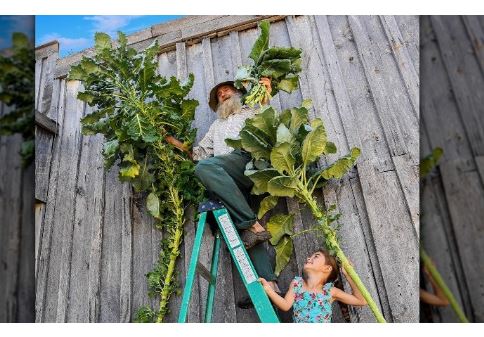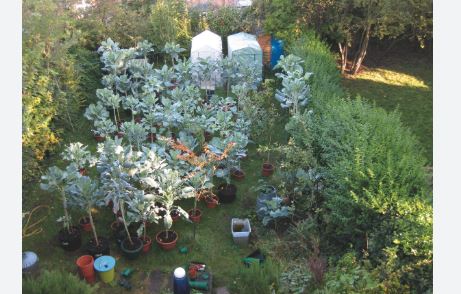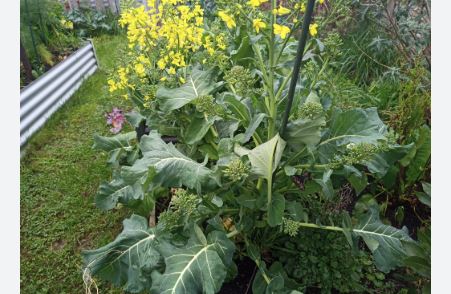
Botanical Classification
Walking Stick Kale, also known as Jersey Kale or Jersey Cabbage, is scientifically classified as Brassica oleracea var. longata. It belongs to the Brassicaceae family, which includes cruciferous vegetables like cabbage, broccoli, and other kales. The oleracea species encompasses diverse cultivated brassicas, while the longata variety denotes this unique, tall-growing kale.
Unlike typical kales in the acephala group, which are non-heading, Walking Stick Kale is distinguished by its elongated, woody stem, bred for both culinary and utilitarian purposes. Its botanical lineage ties it to wild cabbage from the Mediterranean, adapted over centuries for its extraordinary height and sturdy structure.
Origin and History
Walking Stick Kale is native to the Channel Islands, particularly Jersey, located between France and England, where it has been cultivated for over 200 years. Likely derived from wild brassicas, it was developed by island farmers for its dual purpose: providing edible leaves and tall stalks used as livestock fodder and crafting material.
By the 19th century, Jersey growers began drying and varnishing the stalks into walking sticks, with up to 30,000 sold annually by the early 20th century, many exported as souvenirs. Its cultivation declined by the 1970s due to changing agricultural practices and tourism trends, but it remains a rare heirloom grown by enthusiasts in the U.S., particularly in regions with mild climates like California and Oregon, where its historical and ornamental value is appreciated.
Identifying Characteristics

Walking Stick Kale is unmistakable for its towering height, commonly reaching 6-10 feet and up to 18-20 feet under ideal conditions. The plant features a long, sturdy, woody stem, mostly bare, topped with a tuft of large, cabbage-like leaves. The leaves are broad, green to blue-green, with wavy or slightly frilled margins, resembling standard kale but larger and coarser.
Stems are pale green to whitish, often stripped of lower leaves to encourage straight growth for walking stick production. Some growers plant it at an angle to create a naturally curved handle at the root end. Its tropical, palm-like appearance makes it a striking ornamental in U.S. gardens.
Taste
The leaves of Walking Stick Kale have a flavor similar to other kales, offering a mild, nutty, and slightly bitter taste with earthy and peppery notes. Younger leaves are tender and less bitter, suitable for raw or lightly cooked dishes, while older leaves are tougher and more robust, better suited for cooking to soften their texture and reduce bitterness.
Frost exposure enhances sweetness, as with other kales, by converting starches to sugars. While not as palatable as tender varieties like Lacinato, its leaves are edible and nutritious, though historically used more for animal fodder than human consumption.
Seasons/Availability
Walking Stick Kale is a cool-season crop, thriving in mild climates with temperatures between 7-24°C (45-75°F), and is hardy down to -12°C (10°F). In the USA, it’s typically sown in late summer (July-August) for fall-winter harvests or early spring (February-March) for summer yields, suited to USDA zones 6-9.
It’s grown as an annual or short-lived perennial, with harvests possible year-round in mild climates like coastal California. Due to its rarity, Walking Stick Kale is not widely available in U.S. markets, primarily found in home gardens, specialty nurseries, or through heirloom seed suppliers like Baker Creek, with peak availability from late fall to early spring.
Culinary Uses

Walking Stick Kale’s leaves are edible and can be used like other kales, though they are less commonly consumed due to their coarser texture. Young, tender leaves are best for raw salads, smoothies, or lightly sautéed with garlic and olive oil, offering a nutty flavor. Older leaves, tougher and more bitter, are suitable for soups, stews, or stir-fries, where cooking softens their texture.
Historically, the leaves were primarily used as fodder for livestock, feeding sheep and cows on Jersey, but modern gardeners incorporate them into dishes like wraps or baked kale chips. The plant’s primary cultural significance lies in its stalks, dried and crafted into walking sticks, rather than its culinary applications.
Nutritional Value
Walking Stick Kale shares the nutritional profile of other kales, being low in calories (about 49 kcal per 100 g raw) and rich in vitamins, minerals, and antioxidants. It’s an excellent source of vitamins K, A, and C, providing over 100% of daily needs per serving, supporting blood clotting, vision, and immune health.
It contains 2-3 grams of fiber per cup, aiding digestion, and is high in calcium, magnesium, and potassium for bone and heart health. Like other brassicas, it provides glucosinolates, such as glucoraphanin, which may form sulforaphane, under research for potential anti-cancer benefits. Boiling reduces some nutrients, but steaming or stir-frying preserves most. Its nutritional value makes it a worthy, if underutilized, superfood.
Cultivation of Walking Stick Kale (Jersey Kale)
- Climate and Season: Walking Stick Kale grows best in mild, cool climates with temperatures between 7-24°C (45-75°F) and is hardy to -12°C (10°F). In the USA, plant in late summer (July-August) for fall-winter harvests or early spring (February-March) for summer yields. It thrives in USDA zones 6-9, with year-round cultivation possible in mild areas like coastal California.
- Site Selection: Choose a site with full sun (6-8 hours daily) to promote strong stem and leaf growth, though partial shade is tolerated in warmer regions like Southern California to reduce heat stress. Ensure good air circulation to minimize fungal diseases, particularly in humid areas like the Pacific Northwest.
- Soil Requirements: Prefers fertile, well-drained, loamy soil with a pH of 6.0-7.5. Enrich with organic matter like compost or aged manure. In regions with heavy clay (e.g., parts of Oregon) or sandy soils (e.g., coastal areas), amend with compost to improve drainage and support robust stem development.
- Soil Preparation: Loosen soil to 12-18 inches deep to accommodate deep roots, mixing in 2-3 inches of compost or organic matter. Remove rocks and debris to ensure straight stem growth, crucial for walking stick quality. Conduct a soil test via local extension services (e.g., USDA’s NRCS) to confirm pH and nutrient levels, adjusting with lime or sulfur as needed.
- Planting: Sow seeds ½ inch deep, spacing 18-24 inches apart in rows 2-3 feet apart to allow for its tall growth (6-20 feet). Transplant seedlings started indoors 8-10 weeks earlier for faster establishment, common in shorter-season areas. For curved walking sticks, plant on a 45-degree slope, a traditional Jersey technique adaptable in the U.S.
- Watering: Maintain consistent soil moisture, providing 1-1.5 inches of water weekly, adjusting for rainfall. Use drip irrigation, common in dry states like California, to keep foliage dry and reduce disease risk. Mulch to retain moisture, especially in regions with hot summers like the Southwest.
- Fertilization: Apply a balanced fertilizer (e.g., 10-10-10) at planting, followed by a nitrogen-rich fertilizer (e.g., fish emulsion) every 4-6 weeks to support leafy and stem growth. Avoid over-fertilizing to prevent weak stems unsuitable for crafting, a concern in fertile regions like the Willamette Valley.
- Mulching: Add a 2-3 inch layer of organic mulch, such as straw or bark, to conserve moisture, suppress weeds, and keep roots cool. This is particularly effective in regions with temperature fluctuations, like the Northeast, to stabilize soil conditions for tall plants.
- Pest Management: Monitor for pests like aphids, cabbage worms, and flea beetles, common in U.S. brassica crops. Use floating row covers in organic farms (e.g., Oregon), neem oil, or introduce beneficial insects like ladybugs, popular in California. Hand-pick caterpillars for small gardens, effective nationwide.
- Disease Control: Prevent fungal diseases like powdery mildew and black rot, possible in humid regions like coastal areas, by ensuring air circulation and avoiding overhead watering. Rotate crops every 2-3 years, a standard practice in states like California, to reduce soil-borne pathogens.
- Harvesting: Harvest leaves when 6-12 inches long, about 60-90 days after planting, cutting outer leaves to encourage regrowth. For walking sticks, cut mature stems (2-3 years old) in late fall, strip leaves, and dry for 6-12 months. Regular leaf harvest maintains plant vigor, suitable for U.S. home gardens.
- Succession Planting: Sow seeds every 2-3 weeks in late summer for continuous leaf harvests in milder climates like California. In cooler regions like New York, focus on single plantings for stem production, as walking stick harvesting requires longer growth cycles.
- Storage and Preservation: Store fresh leaves at 0-4°C (32-40°F) in a perforated plastic bag in the refrigerator for up to 2-3 weeks, standard for U.S. households. For long-term storage, blanch leaves for 2-3 minutes, cool in ice water, dry thoroughly, and freeze to preserve nutrients. Dry stems in a cool, ventilated area for walking stick crafting.